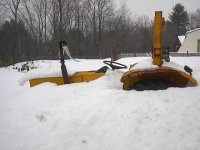I am not sure how cold it gets where NIdaho lives but we have 40+ days on average when the temperature gets below zero. I know how frustrating and time consuming having diesel fuel gel can be.
My solution is very simple. I use #1 diesel when the temperature could conceivably get below zero. The cloud point (i.e., when a grade of diesel begins to gel) for #1 diesel is -40 F. If you use #1, unless it is colder than -40, you don't have to worry about gelling. You do have to worry about the lack of lubrication in #1 diesel, so you need to add a lubricating additive. I use Opti-Lube XPD. It is a little expensive but is rated as the best.
Despite what LBrown said it is perfectly acceptable to mix #1 and #2 diesel. #2 diesel has a cloud point of +40. Blending them has a linear effect on the cloud point. Blending 50% #1 and 50% #2 diesel has a cloud point of 0. Putting in the additive will have some effect on the cloud point also. That is what I did with the last batch of fuel I put in my tractor. Even though the average low for my location this time of year is 20, I like to have a huge margin of error.
Is there any harm in using #1 with adequate lubricant? #1 costs a bit more, it has less energy per gallon than #2, and the adative also adds to the cost. So in the end maybe using appropriately, prepared #1 diesel cost 20% more than #2. The cost and hassle factor of having diesel gel is going to be much higher for me.
I can't leave this topic without discussing "winter blend". They sell "winter blended" diesel at gas stations around here. If you go into the station and ask the clerk what is the cloud point (or if you don't want to totally baffle them, you might ask them at what temperature will the fuel begin to gel), I will bet 99+% of the time they won't know the answer. We used to have 2 diesel cars. My wife would buy the winter blend. Occasionally we get those -30F to -40F spikes in temperature and her car would start up and go a couple of hundred yards and die. Because she had to get to work before me, she would take my car, telling me what happened, and then I would have to spend half a day getting the car back home using a blow torch to heat up the fuel filter and fuel line while freezing my butt off.
What was the problem with the "winter blend"? The are blending #1 and #2 to hit the average for your area. When you get a low temperature spike, you are screwed. I do my own blending.
